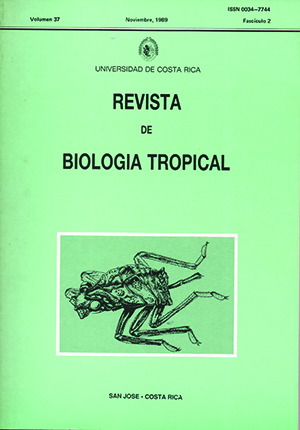Resumen
Of two estuaries studied by means oC the C14 method, the Tacarigua lagoon showed the highest values of production, generally above 30 mgC/m3/hr, with a peak of 187.76 mgC/m3/hr. In Maracaibo the highest recorded value was 46.33 mgC/m3/hr. but with an irregular vertical distribution attributable to strong vertical mixing. A marine locality on the coast showed values considerably lower (2-3 mgC/m3/hr)Citas
D'Elia, C.F. 1986. Gradients in factors limiting primary productivity, p. 1-59. In: J.C. Ogden & E.H. Gladfelter (eds.), Caribean coastal marine productivity, UNESCO Reports in marine Science 41.
Martinet, J. & C. Saint Felix. 1982. Primary production of Atlantic coastal waters of Martinique. Caribb. J. Sci. 18: 103-105.
McLusky, D.S. 1981. The estuarine ecosystem. Blackie, Glasgow. viii+150 p.
Parsons, T.R., Y. Maita & C.M. Lalli. 1984. A manual of chemical and biological methods of analysis. Pergamon Press, Oxford.
Parsons, T.R., M. Takahashi & B. Hargrave. 1979. Biological
Oceanographic Processes, 2nd ed. Pergamon Press, Oxford. xi+332 p.
Rodríguez., G. 1973. El Estuario de Maracaibo. Instituto Venezolano de Investigaciones Científicas, Caracas. 396 p.
Rodríguez, G. 1974. Producción Primaria, p. 61-67 In: Fundación La Salle (eds.). Carta pesquera de los mares orientales de Venezuela.
Tundisi, J. & T.M. Tundisi. 1972. Sorne aspects of the seasonal cycle of the phytoplankton in tropical inshore waters. Ciencia e Cultura 24:189-193.
Vollenweider, R.A. 1974. Chemical and physico-chemical procedures directly ¡nvolved in primary production measurements. In: R.A. Vollenweider (ed.). A manual of methods for measuring primary production in aquatic environments. IBP Handbook 12. 2nd ed. Blackwell Scientific Publications.
##plugins.facebook.comentarios##

Esta obra está bajo una licencia internacional Creative Commons Atribución 4.0.
Derechos de autor 1989 Revista de Biología Tropical


